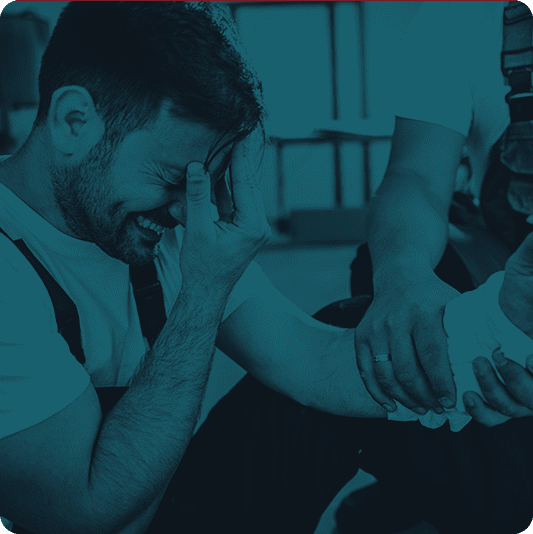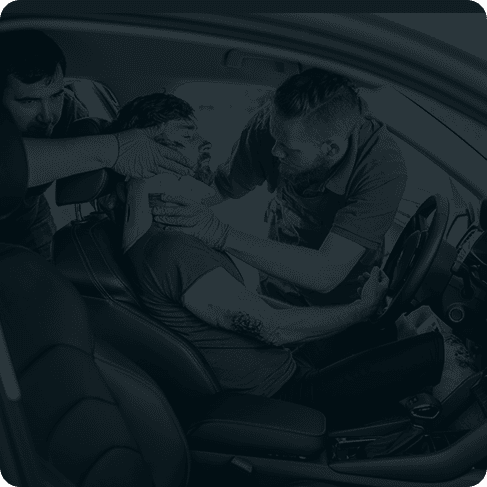“How much are we looking at? I know you can’t promise a number, but…what do you think?”
The question most asked of our injury attorneys is regarding case value.
Of course, it is! If you bring a claim, you will naturally wonder about the future result.
Here we are going to go, step by step, through the process of valuing a personal injury claim the right way. The way every case is evaluated in our firm.
Quick Links:
- First: The Basics of Why You Have a Claim in the First Place
- What to Compensate: Economic Vs. Non-Economic Damages
- Why it Takes Time to Settle a Personal Injury Claim
- How to Calculate Case Value: Step by Step
- FAQ’S On The Valuation of A Personal Injury Case
We are going to do some real work here. If going through the A-to-Z process is not your cup of tea, feel free to play with our personal injury calculator. Recognize though that while quick and fun, the calculator only gives you a vague range that may or may not apply to your case.
| Prefer to see actual examples of specific cases and settlement values? We have specific client examples for auto accident claims for common insurance companies including Geico, Progressive, USAA, and State Farm. Review this to see how this plays out in action. |
Remember, you are unique. And so is your case.
First: Why You Have a Claim in The First Place
Before we dive into how we value your claim, let’s understand the why of a personal injury settlement claim. Then, let’s briefly discuss the different types of damages that factor into your claim’s value.
Finally, we will go through our step-by-step process to determine the value of a personal injury claim.
A personal injury claim is simply about putting a dollar amount on what has been taken from you by another person’s negligence.
Negligence is when another person breaks safety rules and causes harm as a result.
That’s the whole thing.
For example, imagine Bob, driving a Dodge Charger, is texting and takes his eyes off the road. He slams his vehicle into the back of your Nissan Maxima. We all know that keeping your eyes open and looking forward is a basic safety rule of the road. Therefore, Bob’s negligence caused the collision.
Thus, Bob is responsible for anything he broke or damaged due to his negligence.
That can be property damage to your vehicle. It could be the diminished value of your vehicle. It could be the medical bills you accumulated if you had to see a doctor.
Most importantly, it can be for the pain, suffering, and inconvenience he caused you. Your human damages.
In our system of civil justice, we must put a dollar amount on these damages. Bob (through his insurance) must pay a reasonable amount of money to make things right.
Reasonable Amount of Compensation is 100% of the value of what was broken, damaged, or taken away.
Money compensation is more civilized than an “eye for an eye.” It is better than grabbing revolvers and dueling in the street.Not a perfect system, but the best in the world.
Now, let’s go into the categories of damages that determine how much your case is worth.
What to Compensate: Economic Vs. Non-Economic Damages
Damages fall into two categories: economic and non-economic.
Economic damages are the easiest to understand.
In a car wreck case, the damage to a vehicle is economic damage. So are medical bills, lost wages, and diminished value.
Non-economic damages are a bit trickier.
Often casually called “pain and suffering,” non-economic damages include:
A wise man once said, “Everything that’s worthwhile in life came to us for free and our minds, souls, bodies, hopes, dreams, ambitions, intelligence, love of family and children and friends and country. All of these priceless possessions are free. But these things are gone, we can never replace them.”
“Everything that’s worthwhile in life came to us for free and our minds, souls, bodies, hopes, dreams, ambitions, intelligence, love of family and children and friends and country. All of these priceless possessions are free. But these things are gone, we can never replace them.”
Non-economic damages are compensation for the interference with or loss of our priceless rights that we are born with. We did not pay for our natural right to live on our terms, free of pain, and able to do as we wish.
Now, insurance companies try to discount non-economic damages and give them a bad rap. But non-economic damages are the human damages that give life its value.
For example, imagine you have a prized Picasso painting hanging in your house. It is destroyed in a fire.
The economic damages would be the fair value of the painting. What the painting would sell for at an auction. The economic damage is temporary: the insurance company writes a check, and you cash it. You have been compensated for your economic loss.
The non-economic loss is the love you have for the painting. The pride you have knowing that this painting was passed down two generations in your family. The sadness or pain you feel believing you failed your family by not protecting the painting is non-economic.
Consider a 13-year-old family dog. As an economic asset, the value of the dog is not very much. Your dog is partially blind and has arthritis. People spend big dollars on cute puppies, not old dogs that sleep on the couch.
But the non-economic asset is the memory of the great times you have had with the dog. The feeling of running your hand on his head when he sleeps on your lap. What would you take in a trade to give up your family dog? I am going to guess if there is even a number, it has a bunch of zeroes attached to it.
What would it take in a trade to give up your pet? Your ability to exercise? Your ability to sleep peacefully? These are non-economic assets, and they are probably priceless to you.
If you have a permanent injury, your non-economic damages are often large future damages. In a car accident case, the non-economic damages might include the inability to sleep through the night because of a herniated disc in the neck. This might reasonably continue for years into the future until surgery.
Why it Takes Time to Settle a Personal Injury Claim
Personal injury claims are rarely settled “fast.” That’s because we need to wait enough time to see if an injury is permanent and to learn exactly how the injury will affect you in the future.
The doctors call it reaching “maximum medical improvement” or “MMI.” For a spinal injury, it can take a person three to six months to reach maximum medical improvement.
That means it is three to six months before we even know if your injuries are permanent. Let alone before we know how these permanent injuries will continue to affect you in the future.
We often can’t determine your damages for 3-6 months or more until your body has healed the best it can. Doctors call this “Maximum Medical Improvement”.
And we certainly would never want to begin negotiating your claim until we know if your injuries are permanent!
Think of it this way.
Sometimes people get into car wrecks. They are sore with strained muscles. But they feel better in a couple of weeks.
For these people, the claim value for any injuries will be relatively low because they do not have permanent injuries. To determine their case value, we simply need to get a fair number for those couple of weeks when they were hurt.
But sometimes people are in car wrecks and they suffer herniated discs. They do conservative therapy with a physical therapist or chiropractor for 10 to 12 weeks. They also see a surgeon for evaluation. And at the end of the 12 weeks, they are still hurting.
It becomes clear to the doctor that in some measure, this injury will affect the person forever.
In that case, we need to make sure we get a fair settlement that will account not just for the past, but also the future.
And when we consider the average life expectancy of a human, we can be looking at decades that we need to account for!
Not to mention, when a person tries to use conservative therapy for months to get better and it fails, that person often goes to specialists to help minimize and manage pain.
Pain management techniques include medication, epidural steroid injections, ablations, and even surgery.
But not every treatment option will work for everyone.
If treatment is successful in managing pain, great! But now we know that person will need that treatment in the future at certain regular intervals. That is future damage we need to factor into a settlement claim.
Therefore, we can’t initiate settlement talks until we have all the facts and information about a person’s injuries. We need to have sufficient information to project future economic and non-economic damages.
How to Calculate Case Value: Step by Step
First, there is no required formula valuing a case. Florida law requires a jury trial. Each case, like every human, is different. Every case has unique non-economic damages. Every case has specific economic damages.
But while no specific formula exists, Florida law does give us a framework to value a case. That framework is based on what would happen if a jury of your peers was required to determine the value of your case.
See below for the specific instructions jurors must use to determine damages:
Let’s go through it!
1. Determine Total Non-Economic Damages.
First, let’s look at non-economic damages in the past and in the future.
We want to know the human harm. We need to know how bad the harm is, how long it will last, and how much it interferes with your right to live life freely and happily.
Let’s start with past non-economic damages. This will be from the time of your auto wreck or personal injury through today.
Remember, this is pain, loss of enjoyment of life, grief, and other human damages.
You can go through the list below to keep you organized.
These are common categories of non-economic damages.
Back pain that radiates down your leg? Let’s add that to the past pain column.
Does the radiating pain make you unable to exercise or sleep comfortably in your bed at night? That is separate non-economic damage you should account for under loss of enjoyment of life.
After identifying the different categories of non-economic damages, we have to assign a dollar value to each one. One way to think about this is by answering the question, “How much money would it take for me to have to suffer this non-economic damage again?”
For example, “How much would it take for me to sacrifice the full use of my shoulder for a year and a half?” You get the idea.
This takes effort. This is why at our firm we simply must talk to our client and understand all the facts and feelings. This is also why we go through pain and suffering questionnaires with every client before we file a lawsuit. Because each person is unique. Each person has different things they like to do to give them happiness and joy.
For example, imagine the mother of three who loved to garden with her children. She was T-boned in a wreck by a negligent driver. She doesn’t garden anymore because it’s too painful to get in the dirt and carry pots and plants.
For her, she might say that no money is worth losing the experience of gardening with her children. But, knowing the law asks her to be reasonable, she may decide that $5,000 per year in past pain and suffering is reasonable.
The same mother may have issues with sleeping because of her injuries. We need to determine what fair compensation is for her inability to sleep, etc.
Future Non-Economic Damages
Now we turn to future damages.
A big factor in future non-economic damages is how well medical treatments work to minimize pain and allow a person to function.
For example, a common spinal system injury in an auto wreck is a herniated disc. These discs can sometimes put pressure on nerves, causing radiating and debilitating pain.
Pain is unique non-economic damage. For many, pain may wax and wane over time. For many, medical treatment may help manage the pain. But for an unfortunate few, injections do not help manage the pain. For an even more unfortunate few, prior medical conditions make them unable to utilize pain management techniques.
If the treatment helps manage the pain, great! We will acknowledge that when calculating future non-economic damages for pain. However, since we know that these treatments will be needed in the future, we need to account for the costs of future medical treatment.
So perhaps the mother above is in pain an average of two hours a day. She kept a log for a week to determine the amount of pain she suffers. Perhaps for her, $10 an hour is a reasonable trade for her pain. (Or, perhaps not). If so, then calculating the value of her pain is as simple as adding up those hours in the past and multiplying it by $10.
Complete the same exercise you did before now in regard to future non-economic damages.
The hard part is now done. Let’s turn to the economic damages.
2. Determine Total Economic Damages.
With economic damages, we want fair value for past and future medical expenses, lost wages, and property damage.
Sometimes, this is straightforward. The bill to fix your car was $5,738.97. Your medical bills are $22,456.00.
Of course, sometimes there can be a valid disagreement about what is reasonable for economic damages. This is especially true with future medical bills and some expensive medical procedures. But generally speaking, economic damages are easy to calculate for the purposes of determining case value.
Remember, if your vehicle has diminished value (your new vehicle was repaired, but now you can’t sell it for the same amount) that is a past economic loss.
Also remember, if you need medicines to manage your pain and will need them in the future, this is a future economic loss.
Fill in the chart below:
Note: For personal injury cases of a large monetary value, we may hire a life care planner to help put together all of the future medical costs to treat pain. We have seen life care plans that are in the seven figures.
We also need to account for inflation. Just like a gallon of milk was a quarter when Grandpa was a kid, you can expect medical expenses to be much cheaper now than they will be well into the future.
Now, take all of your losses and add them together. This amount is 100% of your damages.
3. Adjust the Value by Fault.
Now we have determined your damages. Hooray! But we must adjust your damages by fault.
Florida (and a majority of states) will reduce your damages based on the appropriate amount of fault.
For example, assume that you were in a car accident where you were speeding and you contributed to the accident.
Maybe you were 20% liable, while the (mostly) negligent driver is 80% liable.
You would want to reduce your damages by 20% to account for your share of the liability.
4. Insurance Policy Considerations.
There is a difference between what your case is worth and what you can actually collect. The long and short is that, except in rare circumstances, there needs to be insurance available to pay your claim.
Florida currently does not require bodily injury insurance. So, some people do not carry insurance since it is not required. We’ve had cases where the case value was millions of dollars, but there was simply no money available to collect because the negligent party did not have any insurance.
Other times, the bad driver has insurance — but the amount of insurance is not enough to cover your damages.
Here is how we handle those situations:
If we have been transparent and made it clear to the insurance company that the case should settle for the smaller policy, then the insurance company has two choices: do the right thing and pay or make a low-ball counteroffer.
If the insurance company does the right thing, then the case is closed — at least with that insurance company. (It is not uncommon to have multiple insurance policies at play.)
If the insurance company does the wrong thing and tries to lowball us, they may have “opened up the policy” by acting in bad faith to its own insured.
See, the negligent party’s insurance company has a duty to protect the negligent party. If the insurance company does not pay a claim they obviously should have paid and therefore exposes its insured to a lawsuit, they have violated the rules of fair play. Sometimes, this results in us being able to collect full justice for our client from the insurance company — even if the policy limits were small.
FAQ’S On The Valuation of A Personal Injury Case
Our Expertise
We have your back. Whatever you might be suffering from, accidents, injuries or medical malpractice, we have you covered throughout Florida
Let’s get in touch!
The initial consultation is absolutely FREE
Denmon Pearlman
Law
Tampa Office
2504 W Crest Ave
Tampa, FL 33614
(813) 554-3232
Denmon Pearlman
Law
St. Petersburg Office
520 2nd Ave South
St. Petersburg, FL 33701
(727) 493-5610
Denmon Pearlman
Law
New Port Richey Office
5703 Main Street
New Port Richey, FL 34652
(727) 753-0049
Denmon Pearlman
Law
Brooksville Office
1790 E Jefferson St.
Brooksville, FL 34601
(352) 309-7354
Denmon Pearlman
Law
Seminole Office
5290 Seminole Blvd. Suite D
St. Petersburg, FL 33708




